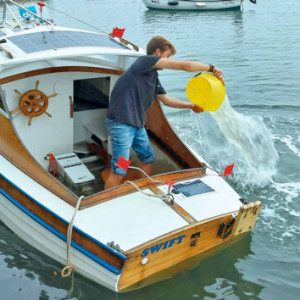What happens to boat electrical systems and batteries if submerged?

After fitting an electric engine to his 19ft river boat, Bob Shillito thought he could look forward to years of hassle free cruising, until his boat sank

Emptying the damaged boat the hard way, fearful of bursting the clinker planking by dragging her out full of water. Credit: Bob Shillito
After converting my river boat to run on an electric engine in the spring of 2022, I was asked several times; What happens to boat electrical systems and batteries if there is water ingress? Would the batteries explode?
Sadly, I found out the answer on a drizzly Sunday in October 2023 when Swift sank! By that time, she'd been in successful operation for a season and a half and had provided many hours of boating happiness, so I was devastated to get a call from the harbour patrol alerting me to the crisis.

The hole caused by the steel hoop atop the mooring weight. Two bilge pumps could not compete with it.
Credit: Bob Shillito In a piece of misfortune, during the lowest tide of the year, she'd settled onto her own mooring weight, which had punched a hole in the underside. This was unconnected with the conversion, since the boat's electrical system's combined weight was less than the original two-stroke motor - but that did not alter the fact that my expensive electronics were under the sea.
Explosion risk
So, what of the batteries,[1] containing 5kWh of power?
I warned the harbour staff of a potential risk and we recovered the boat, submerged to the gunwales, to the slip. The system operates at 48V, which is not generally considered dangerous, but discretion seemed wise as I waded into the boat. There was no drama; no fizzing or exploding components, so, with the help of a sympathetic bystander, I emptied the boat and wrestled her onto a trailer.
The next day, an inspection found the power cables to be severely damaged by electrolytic corrosion[2] and the main 150A fuse and fuse holder were fried. The batteries appeared intact, but one felt warm, so I cautiously put them all in the middle of the garden.

Despite being wrecked, all four batteries retained considerable charge and needed to be discharged safely. Credit: Bob Shillito
Once I unscrewed the casings it was obvious water had got inside, creating a complete mess. It seems a design oversight not to make the battery casing watertight. Every other part of the electrical system that had been submerged was also damaged, including the power electronics in the engine controller.
A small amount of seawater had got inside the motor, so I rinsed it out with fresh water in the hope that it might recover. Some of the components: the solar panels[3], solar charge controller, motor display and throttle unit, had not been submerged and appeared undamaged, so I retained them. An insurance[4] claim was prepared, and a surveyor inspected the boat, declaring that the claim was valid: the boat wasn't a rotten hulk, and I hadn't been negligent, so I set about repairs.
As the hole was in the garboard and included a broken rib, I commissioned Marcus Lewis, a master clinker boatbuilder in Fowey. The electric motor went to specialists CPMR in St Austell.
The team there regularly repair damaged electric pumps and were unfazed by this motor, which they baked dry, fitted with new bearings and tested before returning a few days later for less than ?200. Direct replacements for the batteries were no longer available, but there are many similar so I selected some with the same capacity.
I chose Ecoworthy 100Ah batteries, priced less than half that of the originals (and, now, in 2025, less than a third: four for ?760, such is the pace of change in the world of batteries).
Full revival
Waterworld, the motor system's makers, are based in the Netherlands and no longer have a UK distributor. However, they helpfully sent replacements for the other damaged components. The new items cost about ?2,000.
When the controller arrived, it wouldn't work and detailed communication was required to figure out it had the wrong firmware revision. I was sent another unit, but returning the first was quite a hassle in the post-Brexit world of import/export paperwork. There should be a way of upgrading firmware in situ.
A fully revived Swift was back on the water for the 2024 season and performed perfectly throughout. She made the trip to a festival in Looe (where she was built in 1962), completing the 11-mile journey with nearly 40% battery remaining. She continues to turn heads with her old-fashioned lines contrasting with high-tech solar panels, and amazes people with her near-silent motoring.
Swift remains a great boat, despite her near demise.
Want to read more practical articles, like What happens to boat electrical systems and batteries if submerged?
A subscription to Practical Boat Owner magazine costs around 40% less than the cover price.
Print and digital editions are available through Magazines Direct - where you can also find the latest deals[5].
PBO is packed with information to help you get the most from boat ownership - whether sail or power.
-
-
-
- Take your DIY skills to the next level with trusted advice on boat maintenance and repairs
- Impartial in-depth gear reviews
- Practical cruising tips for making the most of your time afloat
-
-
Follow us on Facebook, Instagram, TikTok[8] and Twitter[9][6][7]
References
- ^ batteries, (www.pbo.co.uk)
- ^ electrolytic corrosion (www.pbo.co.uk)
- ^ solar panels (www.pbo.co.uk)
- ^ insurance (www.pbo.co.uk)
- ^ are available through Magazines Direct - where you can also find the latest deals (www.magazinesdirect.com)
- ^ Facebook (www.facebook.com)
- ^ Instagram, (www.instagram.com)
- ^ TikTok (www.tiktok.com)
- ^ Twitter (twitter.com)